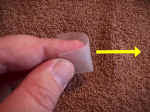|
|
Operational Obstetrics & Gynecology
Contraceptive Vaginal Film
Contraceptive vaginal film is available for use as either a primary method of contraception or to increase the effectiveness of other methods, such as condoms.
Each film is a semi-transparent square of a dissolvable material containing nonoxynol-9, a standard spermicide.
After opening the individual film wrapper, the film is removed and folded once in half. Use dry fingers; otherwise the film will being to melt and will become unmanageable.
 The film is then folded in half once again and folded over the index or middle finger.
Push the folded film deep into the vagina so that it is up against the cervix.
The film is then folded in half once again and folded over the index or middle finger.
Push the folded film deep into the vagina so that it is up against the cervix.
After insertion, the film needs 15 minutes to melt to form an effective spermicidal barrier. Once in place, it is effective for up to one hour after insertion. If additional intercourse is performed, an additional film should be inserted.
The film dissolves completely and does not need to be removed. It will be discharged over time with the normal vaginal secretions and body fluids. If douching is desired, it should not be done during the first 6 hours after intercourse as some of the contraceptive protection may be lost.
Because the active ingredient is nonoxynol-9, some individuals (up to 20% of the population) will be sensitive to it and experience a burning sensation during use. Those individuals should not continue to use this method of contraception and should seek another alternative.
Effectiveness of the film is probably similar to that of the diaphragm. If used carefully and consistently, about 5 women out of 100 will become pregnant each year, despite the use of contraceptive vaginal film. For the average user, failure rates are likely higher, about 15 or 20% each year.
*This video is an added feature, provided by the Brookside Associates Medical Education Division. It was not present in the original edition.
Home · Introduction · Medical Support of Women in Field Environments · The Prisoner of War Experience · Routine Care · Pap Smears · Human Papilloma Virus · Contraception · Birth Control Pills · Vulvar Disease · Vaginal Discharge · Abnormal Bleeding · Menstrual Problems · Abdominal Pain · Urination Problems · Menopause · Breast Problems · Sexual Assault · Normal Pregnancy · Abnormal Pregnancy · Normal Labor and Delivery · Problems During Labor and Delivery · Care of the Newborn
|
Bureau of Medicine
and Surgery |
Operational
Obstetrics & Gynecology - 2nd Edition |
 This
web version of Operational Obstetrics & Gynecology is provided by
The Brookside Associates
Medical Education Division. It contains original contents from the
official US Navy NAVMEDPUB 6300-2C, but has been reformatted for web access and
includes advertising and links that were not present in the original version.
This web version has not been approved by the Department of the Navy or the
Department of Defense. The presence of any advertising on these pages does not
constitute an endorsement of that product or service by either the Department of
Defense or the Brookside Associates. The Brookside Associates is a private
organization, not affiliated with the United States Department of Defense. All
material in this version is unclassified.
This
web version of Operational Obstetrics & Gynecology is provided by
The Brookside Associates
Medical Education Division. It contains original contents from the
official US Navy NAVMEDPUB 6300-2C, but has been reformatted for web access and
includes advertising and links that were not present in the original version.
This web version has not been approved by the Department of the Navy or the
Department of Defense. The presence of any advertising on these pages does not
constitute an endorsement of that product or service by either the Department of
Defense or the Brookside Associates. The Brookside Associates is a private
organization, not affiliated with the United States Department of Defense. All
material in this version is unclassified.
This formatting © 2006
Medical Education Division,
Brookside Associates, Ltd.
All rights reserved